Distinguished Critique: Batman: Arkham Asylum: A Serious House on Serious Earth Review
This grim graphic novel is a fascinating character study of Batman and his rogues, discerning how close to the edge our Caped Crusader can crawl
—by Nathan on June 9, 2023—
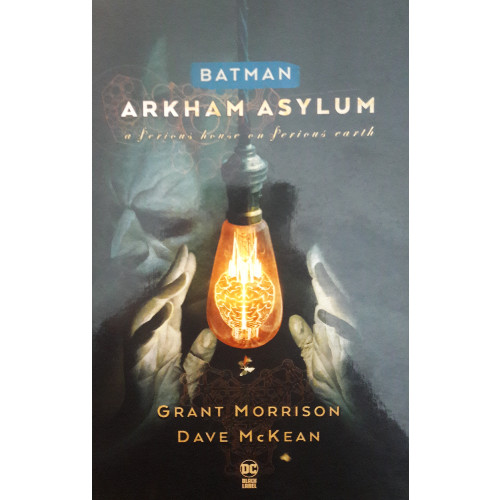
Amadeus Arkham watched his mother ignobly struggle with mental illness until her death. When she passed, he inherited her home and transformed it into a psychiatric hospital, which Amadeus named after her.
"Arkham Asylum."
Interpret that gesture as you will.
This facility "for the criminally insane" is renowned in Batman lore as the hospital where many of the Dark Knight’s adversaries have been institutionalized and have routinely broken free from. Arkham has been spotlighted in numerous stories over the last several decades and depicted in several other forms of media, including Batman Begins, Batman: The Animated Series, Gotham, and perhaps most famously, the Batman Arkham series of video games.
It’s difficult, then, to overstate the importance of the institution to Batman’s mythos…and it’s equally difficult to overstate Grant Morrison’s influence on Arkham through their graphic novel, Arkham Asylum: A Serious House on Serious Earth. The story, in the years since its publication, has gone on to great acclaim, upheld alongside The Dark Knight Returns, "Year One," "Death in the Family", The Long Halloween, and The Killing Joke as an integral chapter in Batman’s history.
I hope to delve a little into the madness and mayhem of Arkham Asylum, exploring what exactly makes this particular graphic novel so fascinating.
Batman: Arkham Asylum: A Serious House on Serious Earth
Writer: Grant Morrison
Penciler: Dave McKean
Inker: Dave McKean
Colorist: Dave McKean
Letterer: Gaspar Saladino
Issue: Batman: Arkham Asylum: A Serious House on Serious Earth graphic novel
Publication Date: October 1989
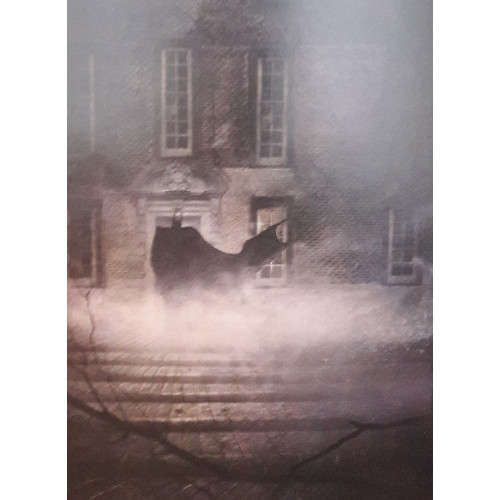
Note: save for some minor edits, this blog is the same as it was when I originally posted it to Hubpages
This graphic novel is an incredibly dense work of fiction, layered in philosophical, psychological, and religious symbolism. I am, primarily, going to skirt around this, my general unfamiliarity with Morrison’s broader work and their beliefs hampering any intention to properly give such notions credence. I wish, instead, to dig into the story itself.
On the face of it, Arkham Asylum appears simple. Led by the fiendish Clown Prince of Crime, the inmates of Arkham have rioted and taken control of the asylum (insert "inmates running the asylum" joke here). The Joker demands Batman show up and journey through the darkness with them. Through this premise, Morrison explores not only the Dark Knight Detective's psyche but the minds of the inmates themselves, providing readers with a grim trip down the rabbit hole.
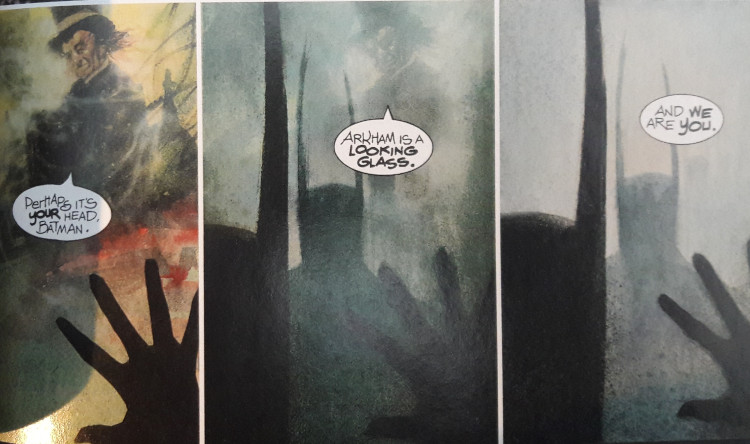
The premise, to me, is simply a narrative mechanic for Morrison to pull our Dark Knight Detective into the asylum. Once inside, Batman is given ample opportunity to engage with his rogues gallery; likewise, Morrison is given various chances to explore what makes these prisoners, and by extension their winged-wrapped warden, tick. The story itself–the struggle through the dredges of the institution–is not as important as how Batman emerges from the other side. What are to learn about our famed hero and his fearsome foes?
By throwing Batman in with the lunatics, Morrison stresses the point that, just maybe, Batman is a tad more at home inside the asylum than outside. "Enjoy yourself out there," the Joker tells Batman at the end of the graphic novel as the vigilante leaves Arkham. "In the asylum. Just don’t forget–if it ever gets too tough…there’s always a place for you here." Thus, Batman is thrust into a world of insanity and evil that he must confront and combat yet simultaneously faces the risk of falling headlong into. He faces corruption, or perhaps, a deeper look at himself…and a better understanding of who he really is.
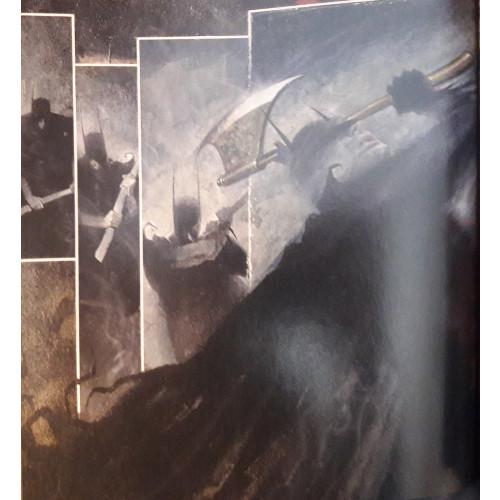
Threading through the novel exists a grim duality between Batman and the villains he encounters. Alan Moore’s The Killing Joke summed up the concept nicely through dialogue–"All it takes is one bad day to reduce the sanest man alive to lunacy," the Joker tells Batman after psychologically torturing the hero through crippling Barbara Gordon and kidnapping her commissioner father. Morrison explores that concept by placing Batman in the heart of madness, wringing him out, and seeing what comes out of the experience. Does Batman emerge as broken as the villains he faces? Is this the "one bad day" which will lead him to smearing white paint across his face and adopting a purple tux over a bat outfit?
As Batman encounters each of his adversaries, distinction is drawn between who he is vs. who they have become. Maxie Zeus, represented as a being of blue energy with aspirations of godhood, offers Batman power in exchange for freedom. Batman ignores him, choosing to surpass his human limitations without the God/Olympian/Christ-imitator’s exchange. Clayface stumbles around the halls, a putrid mass of decaying flesh, looking to taint all around him. Batman pushes him aside, refusing to be corrupted and poisoned. The Mad Hatter is a thief of childhood innocence, mirroring the innocence Bruce lost when his parents were murdered, the innocence he’s tried reclaiming or reinstating in Gotham ever since that night. The villains aren’t perfect opposites of our hero, but they each represent some small antithesis. Godhood vs. humanity. Corruption vs. incorruptibility. Loss of innocence vs. innocence reclaimed.
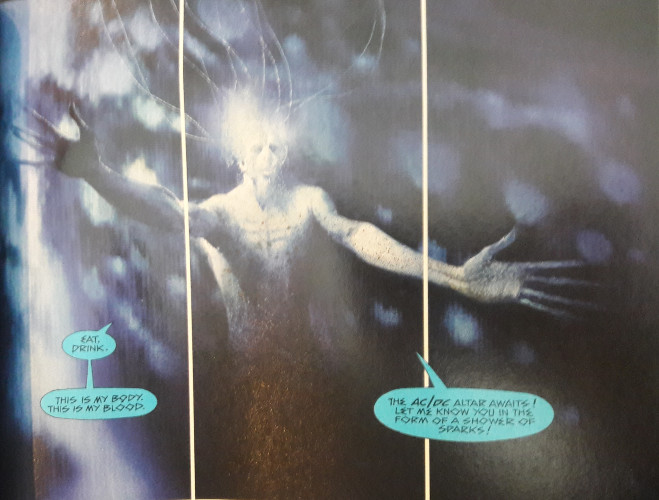
From a narrative standpoint, once you strip away Batman’s connection to each of his rogues, Morrison’s re-imagining of several villains is fascinating. The Joker is an eerie, wraith-like phantom drifting in and out of the pages, toying with Batman and berating him with terms of endearment; a doctor posits the Clown Prince of Crime possesses a kind of "super sanity" which impacts the way he views reality. Two-Face is given a pack of cards instead of his trademark scarred coin; having fifty-two choices instead of two overwhelms Harvey instead of weaning him off the coin. Killer Croc is presented as this formidable mass of muscle and bulk, a figurative dragon Batman must slay and perhaps the villain’s most imposing presence in my mind, aside from his appearance in the Arkham Asylum video game.
These descriptions and dimensions allow Morrison to toy with the depth and concept of each villain, as I discussed above. It’s difficult distinguishing one main personality trait or characteristic that Morrison assigns each antagonist (that is to say, it isn’t like Morrison is trying to figuratively ascribe one of the Seven Deadly Sins to each villain, for example), but Morrison makes them unique and imbues each villain with some type of psychological/philosophical concept. You remember Croc for how physically imposing he is, Two-Face for breaking under the weight of his potential choices, Clayface for his eerily putrescent appearance.
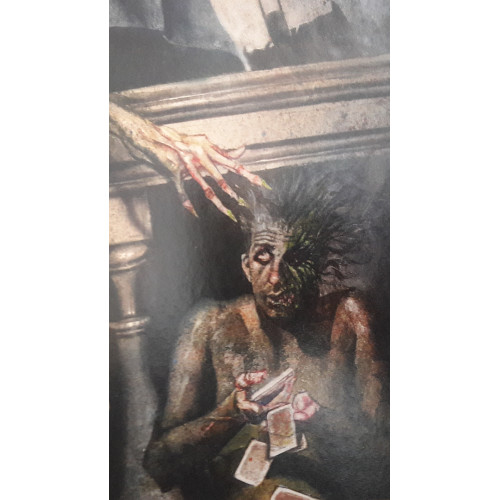

Alongside this central narrative, Morrison weaves in the history of Arkham’s founder, Amadeus. His tale is meant to serve as the antithesis of Batman’s–as the Dark Knight moves deeper into the asylum and confronts all challenges to his sanity, Amadeus breaks under the weight of his own darkness. At one point in the novel, Batman stabs a shard of glass through his hand, a way of finding reality through the pain in the midst of madness. Amadeus just drifts farther and farther; his attempts to rehabilitate a criminal fail when that same criminal escapes a penitentiary and hunts Amadeus’ family. Amadeus returns the favor by treating the criminal to electroshock therapy until the man burns to death.
"Legacy," you could call it. Morrison pulls no punches by draping Amadeus’ legacy in black, making no bones about the fact that the institution Amadeus originally set up to rehabilitate criminals is, during most of the graphic novel, run by the same inmates Arkham Asylum intended to cure. Indeed, as exhibited by Amadeus' treatment of his family's torturer, this guise of help and rehabilitation is swiftly given over to Amadeus' own twisted machinations. Even under it original proprietor, the Asylum never really functions the way Amadeus intended. And Batman is thrust deep into this darkness, subjected to its depths; unlike Arkham, he finds a light in the madness and violence. Darkness, evil, tragedy worm their way through the lives of Amadeus, Batman, and the Dark Knight’s rogues gallery…but how they choose to respond to those shadows, through acceptance or resistance, defines the decisions they make and the people they become.
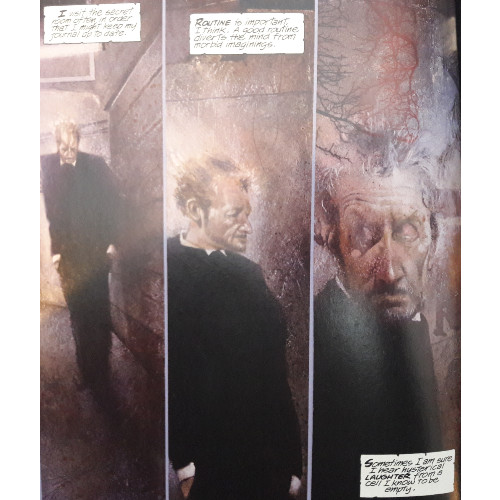
Through all this, Morrison’s words and themes are foundationally reliant on Dave McKean’s illustrations. McKean provides dark, shadowy visuals through a painted medium; his work is incredibly atmospheric, to the point where it feels like he’s creating impressions instead of a fully-realized environment. His figures and settings are defined well enough but sit at the edge of interpretation, allowing the reader to fill in the remaining details. His Batman is a solitary shadow, sweeping through the story; his Arkham is rooms and hallways of darkness and secrets, almost begging the reader to stare a little farther into the yawning abyss; some of his villains are completely unrecognizable from previous or typical forms–as stated earlier, Maxie Zeus is represented as a godlike figure of lighting, more Dr. Manhattan than human; Clayface is a diseased, shambling, bipedal corpse; the Mad Hatter evokes Alice in Wonderland imagery, wrapped in smoke.
Where other artists would imbue their worlds with concrete imagery and details for the reader to suss out, McKean feels more at home in the obscure and opaque. It’s not that you’re unable to figure out what’s happening or that distinguishing characters from the setting is difficult; it’s that you’re asked to concentrate on the details McKean does provide and mentally fill in the spaces. The horror imagined by watching Scarecrow shambling down a hallway and staring at Batman through dark holes is a more frightening experience than if you saw his eyes or if he were allowed to speak.
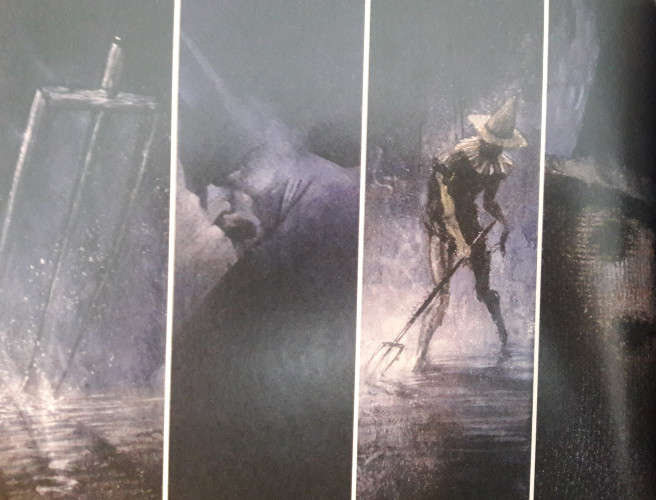
Credit should also be given to Gaspar Saladino for his lettering. Characters each speak distinctly, providing further characterization. Batman’s speech bubbles invert the traditional bubble coloring–black with white wording, outlined in white rings–giving the Dark Knight a unique voice that perhaps fits the tone of his grim demeanor. Maxie Zeus’ speech bubbles are electric blue, lettering constructed in a Greek style to reflect his own beliefs. Clayface’s bubbles are more splotch-like than circular, colored oozing green, similar to his ragged, dripping flesh.
Perhaps most interesting is the Joker’s dialogue. His words are written in red, akin to blood, and not defined by speech bubbles at all. His dialogue is scrawled along panels, altering in size and resisting any sort of conformity or direction. The Joker’s mindset is described by a doctor as a kind of "Tourette’s Syndrome," where the villain recreates his persona almost daily. It makes sense that his words carry a similar concept, characterized by dialogue tumbling out of his mouth, unwilling to conform to the standard method through which speech is typically conveyed in the graphic medium.
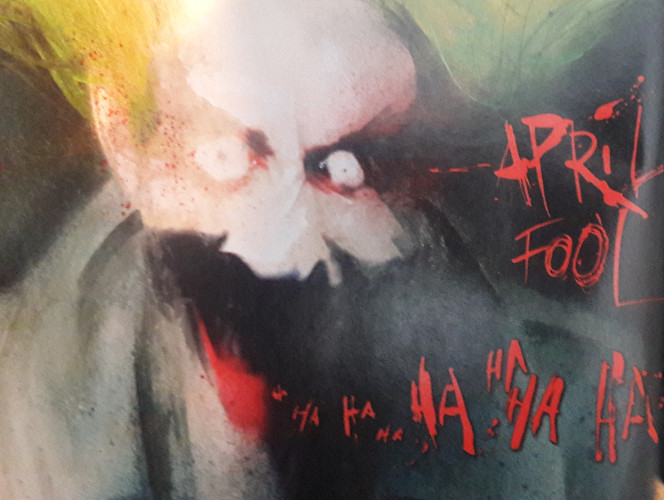
Through voice and imagery, Morrison and McKean both carry this dark tale along. I cannot consider it my favorite Batman story of all time, simply because I struggled to grasp the deeper notions Morrison imbues the narrative with. Regardless, I appreciate Morrison’s characterization, how Batman is pitted, physically and psychologically against his foes, how the Dark Knight must weigh himself against them, how Amadeus’ story serves as the antithesis of Bruce’s tale. A Serious House on Serious House is as deep as it is dark, and should I give it a second read someday, I hope to understand more of the depths of this yawning cavern.